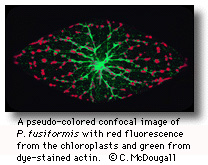| | |
| |
| |
Carrie McDougall
Keywords: Neurobiology, dinoflagellate, control mechanisms
|
I am interested in mechanisms of control in dinoflagellate bioluminescence, specifically in Pyrocystis fusiformis.
My ongoing and future projects include:
- Cytoskeletal transport of bioluminescent organelles and chloroplasts

In dinoflagellates, bioluminescence is emitted from discrete point
sources within the cell. These point sources of light are densifications
of the cytoplasm (i.e. not true organelles) and have been given
the term scintillons. In Pyrocystis fusiformis scintillons change their location from day to night. When the
cell is in dayphase, the scintillons are found in the perinuclear
region. In nightphase, the scintillons are distributed along the
periphery of the cell. If and how these pseudo-organelles are
moved around the cell is unknown. By using various drugs to depolymerize
individual components of the cytoskeleton, such as the actin and
the microtubules, I am trying to isolate which component is responsible
for these movements. I have localized the actin cytoskeleton using
a confocal microscope. Currently, I am determining the location
of the scintillons with a SIT camera attached to a compound scope,
using acetic acid as stimulation.
- Cytoskeletal involvement in bioluminescent flash
After depolymerizing a component of the cytoskeleton, I will determine
if the cells' ability to produce a mechanically stimulated flash
has been affected.
- Calcium and pH imaging of bioluminescent flash
The signal transduction pathway for how a mechanical signal is
transduced into a bioluminescent flash is poorly understood, particularly
in P. fusiformis . Part of this pathway has been shown to involve an action potential
that travels along the vacuolar membrane and triggers hydrogen
ions to come out of the vacuole and into the scintillon, initiating
the bioluminescent reaction. However, the events that lead up
to the action potential are unknown. I am looking for ion fluxes
that might be linked to the bioluminescent flash using various
fluorescent ion indicators. With these indicators I will be able
to determine which ions, as well as where and when, are fluxing.
Initially, my focus will be on calcium and pH.
|
Submitted: 11 Sep 97
The contents of this page are the sole responsibility of the person
named below.
| Carrie McDougall |
| |
|
|
| Marine Science Institute |
| |
|
phone: (805) 893-3639 |
| University of California |
| |
|
|
| Santa Barbara, CA 93106 |
| |
|
|
|
 .
.